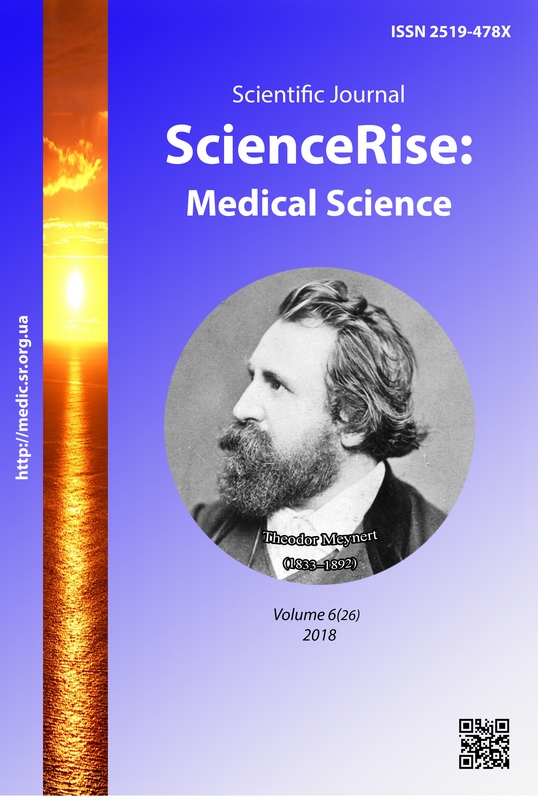Cervical laminoplastic in patients with cerebro-spinal cord injury
DOI:
https://doi.org/10.15587/2519-4798.2018.143364Keywords:
laminoplasty, stenosis, myelopathy, trauma, MRI, ASIA, decompression, instability, operation, organ PRESERVINGAbstract
Cervical laminoplasty is a surgical method of treating the stenosis of the spinal canal in the cervical region, which increases the intraspinal space and allows preserving the integrity of the posterior elements of the vertebrae.
Purpose: The aim of the study was to investigate the efficacy and develop the treatment tactics for patients with posttraumatic cervical spondylotic myelopathy due to stenosis of the spinal canal.
Materials and methods. On treatment in "Dnepropetrovsk Regional Clinical Hospital after named I.I. Mechnikov ", from April 2014 to February 2018 there were 7 patients with posttraumatic cervical spondylotic myelopathy due to stenosis of the spinal canal. The age of the patients was 54-68 years. To assess the effectiveness of the treatment, the ASIA neurological disorders scale was used. The degree of severity of neurological disorders of patients corresponded to C-D. All patients underwent standard SCT and MRI study.
Results of the study. In the early postoperative period, 6 patients showed improvement in their neurological status. Patients of group C - 2 observations (before surgery, muscle strength in the limbs was below 3 points), recovered to category D (muscular strength was more than 3 points). In patients included in the category D - 4 examinations (before surgery, muscle strength was more than 3 points, but did not reach 5 points), there was a complete restoration of muscular strength in the limbs - 5 points. One patient in Group D did not have a neurological recovery.
Conclusions:
1. The operation is organ-preserving and after the operation the spinal cord remains covered with a bone tissue behind it, which prevents the formation of scar tissue directly on the dura mater.
2. Decompression of the spinal cord is achieved without significant disruption of stability, thus reducing the likelihood of postoperative kyphotic deformity and spondylolisthesis.
3. Laminoplasty does not require subsequent spondylodesis, movement remains in the segment, in contrast to the methods that include the installation of the fixation structure, in this connection, the severity of degeneration at adjacent levels may decrease.
4. Carrying out decompressive laminoplasty in patients with traumatic myelopathy, most effective in the early days after trauma, the first 7 days
References
- Oyama, M., Hattori, S., Moriwaki, N. (1973). A new method of posterior decompression. Chubuseisaisi, 16, 79
- Kurokawa, R., Kim, P. (2015). Cervical Laminoplasty: The History and the Future. Neurologia Medico-Chirurgica, 55 (7), 529–539. doi: http://doi.org/10.2176/nmc.ra.2014-0387
- Bydon, M., Macki, M., Kaloostian, P., Sciubba, D. M., Wolinsky, J.-P., Gokaslan, Z. L. et. al. (2014). Incidence and Prognostic Factors of C5 Palsy. Neurosurgery, 74 (6), 595–605. doi: http://doi.org/10.1227/neu.0000000000000322
- Chiba, K., Toyama, Y., Watanabe, M., Maruiwa, H., Matsumoto, M., Hirabayashi, K. (2000). Impact of Longitudinal Distance of the Cervical Spine on the Results of Expansive Open-Door Laminoplasty. Spine, 25 (22), 2893–2898. doi: http://doi.org/10.1097/00007632-200011150-00010
- Tator, C. H. (1995). Update on the Pathophysiology and Pathology of Acute Spinal Cord Injury. Brain Pathology, 5 (4), 407–413. doi: http://doi.org/10.1111/j.1750-3639.1995.tb00619.x
- Salkov, M., Tsymbaliuk, V., Dzyak, L., Son, A., Titov, G., Rodinsky, A. et. al. (2016). Analysis of results of the surgical treatment of the spinal cord injury (step by step). International Journal of Clinical and Experimental Medicine, 2, 110–116.
- Salkov, M., Tsymbaliuk, V., Dzyak, L. (2015). The Method of Multilevel Decompression of Thoracic Spine with the Durotomy and the Local Administration of Cortexin in the Setting in Intradural Space in the Patients with Spinal Cord Injury. International Journal of Neurorehabilitation, 2 (3). doi: http://doi.org/10.4172/2376-0281.1000173
- Chen, H., Deng, Y., Li, T., Gong, Q., Song, Y., Liu, H. (2015). Clinical and radiography results of mini-plate fixation compared to suture suspensory fixation in cervical laminoplasty: A five-year follow-up study. Clinical Neurology and Neurosurgery, 138, 188–195. doi: http://doi.org/10.1016/j.clineuro.2015.09.004
- Duetzmann, S., Cole, T., Ratliff, J. K. (2015). Cervical laminoplasty developments and trends, 2003–2013: a systematic review. Journal of Neurosurgery: Spine, 23 (1), 24–34. doi: http://doi.org/10.3171/2014.11.spine14427
- Hu, W., Shen, X., Sun, T., Zhang, X., Cui, Z., Wan, J. (2014). Laminar Reclosure After Single Open-door Laminoplasty Using Titanium Miniplates Versus Suture Anchors. Orthopedics, 37 (1), 71–78. doi: http://doi.org/10.3928/01477447-20131219-20
- Yang, H.-L., Qian, J., Wang, Z.-F., Chen, G.-D., Xue, F., Sheng, X.-W. (2014). All levels versus alternate levels plate fixation in expansive open door cervical laminoplasty. Indian Journal of Orthopaedics, 48 (6), 582–586. doi: http://doi.org/10.4103/0019-5413.144225
Downloads
Published
How to Cite
Issue
Section
License
Copyright (c) 2018 Mykola Salkov

This work is licensed under a Creative Commons Attribution 4.0 International License.
Our journal abides by the Creative Commons CC BY copyright rights and permissions for open access journals.
Authors, who are published in this journal, agree to the following conditions:
1. The authors reserve the right to authorship of the work and pass the first publication right of this work to the journal under the terms of a Creative Commons CC BY, which allows others to freely distribute the published research with the obligatory reference to the authors of the original work and the first publication of the work in this journal.
2. The authors have the right to conclude separate supplement agreements that relate to non-exclusive work distribution in the form in which it has been published by the journal (for example, to upload the work to the online storage of the journal or publish it as part of a monograph), provided that the reference to the first publication of the work in this journal is included.









